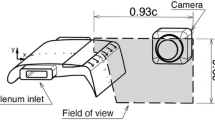Abstract
Vortices and vortex breakdown flow structures over a multi-delta wing configuration are often analyzed by applying flow field invariant analysis techniques from critical point theory and flow topology research. In particular the three invariants of the velocity gradient tensor are used to classify and analyze flow fields, mainly for the assignment of vortical flow regions and assessment of their stability. In this work, the extended optimal triple tensor decomposition is applied to the vortical flow field delivering new tensor fields which allow to recalculate the rate of strain and rotation tensors in an associated basic reference frame. These new tensor fields contain separated distinct flow properties. After retransformation into the original coordinate system, flow field invariant analysis techniques applied to these newly derived tensor fields provide further insights into the dynamics of vortical flows over delta wings.
Access this chapter
Tax calculation will be finalised at checkout
Purchases are for personal use only
Similar content being viewed by others
References
Boukharfane, R., Er-raiy, A., Alzaben, L., Parsani, M.: Triple decomposition of velocity gradient tensor in compressible turbulence. Fluids 6, 98 (2021)
Breitsamter, C.: Unsteady flow phenomena associated with leading-edge vortices. Progr. Aerosp. Sci. 44, 48–65 (2008)
Chakraborty, P., Balachandar, S., Adrian, R.J.: On the relationships between local vortex identification schemes. J. Fluid Mech. 535, 189–214 (2005)
Chong, M.S., Perry, A.E., Cantwell, B.J.: A general classification of three-dimensional flow fields. Phys. Fluids A 2(5), 261–265 (1990)
Gao, F., Han, L.: Implementing the Nelder-Mead simplex algorithm with adaptive parameters. J. Comput. Optim. Appl. 51, 259–277 (2012)
Gursul, I., Gordnier, R., Visbal, M.: Unsteady aerodynamics of nonslender delta wings. Progr. Aerosp. Sci. 41, 515–557 (2005)
Haller, G., Hadjighasem, A., Farazmand, M., Huhn, F.: Defining coherent vortices objectively from the vorticity. J. Fluid Mech. 795, 136–173 (2016)
Hunt, J.R.C., Wray, A.A., Moin, P.: Eddies, streams and convergence zones in turbulent flows. Center of Turbulence Research Report CTR-S88, pp. 193–208 (1988)
Jeong, J., Hussain, F.: On the identification of a vortex. J. Fluid Mech. 285, 69–94 (1995)
Jones, D.R., Perttunen, C.D., Stuckman, B.E.: Lipschitzian optimization without the Lipschitz constant. J. Comput. Optim. Appl. 79, 157–181 (1993)
Kolář, V.: Vortex identification: new requirements and limitations. Int. J. Heat Fluid Flow 28, 638–652 (2007)
Kolář, V., Šístek, J., Fehmi Cirak, F., Moses, P.: Average corotation of line segments near a point and vortex identification. AIAA J. 51(11), 2678–2694 (2013)
Lambourne, N.C., Bryer, D.W.: The bursting of leading-edge vortices - some observations and discussion of the phenomenon. ARC R & M, No. 3282 (1961)
Lugt, H.J.: The dilemma of defining a vortex. In: Müller, U., Roesner, K.G., Schmidt, B. (eds.) Theoretical and Experimental Fluid Mechanics, pp. 309–321. Springer, Heidelberg (1979). https://doi.org/10.1007/978-3-642-67220-0_32
Moffat, H.K., Tsinober, A. (ed.): Topological Fluid Mechanics. Proceedings of the IUTAM Symposium in Cambridge (1989)
Truesdell, C.: The Kinematics of Vorticity. Indiana University Press (1954)
Zastrow, J., Probst, A.: Vortex topology mode alternation in hybrid RANS-LES simulations of transonic flow over the DLR-F23 combat aircraft wind tunnel model. In: Stab Symposium (2022)
Acknowledgments
The authors gratefully acknowledge that this work could be conducted within the project “DIABOLO” funded by DLR.
Author information
Authors and Affiliations
Corresponding author
Editor information
Editors and Affiliations
Rights and permissions
Copyright information
© 2024 The Author(s), under exclusive license to Springer Nature Switzerland AG
About this paper
Cite this paper
Rütten, M., Werner, M., Zastrow, J. (2024). Invariant Analysis of Vortical Delta Wing Flow Using the Extended Optimal Triple Tensor Decomposition. In: Dillmann, A., Heller, G., Krämer, E., Wagner, C., Weiss, J. (eds) New Results in Numerical and Experimental Fluid Mechanics XIV. STAB/DGLR Symposium 2022. Notes on Numerical Fluid Mechanics and Multidisciplinary Design, vol 154. Springer, Cham. https://doi.org/10.1007/978-3-031-40482-5_61
Download citation
DOI: https://doi.org/10.1007/978-3-031-40482-5_61
Published:
Publisher Name: Springer, Cham
Print ISBN: 978-3-031-40481-8
Online ISBN: 978-3-031-40482-5
eBook Packages: EngineeringEngineering (R0)




